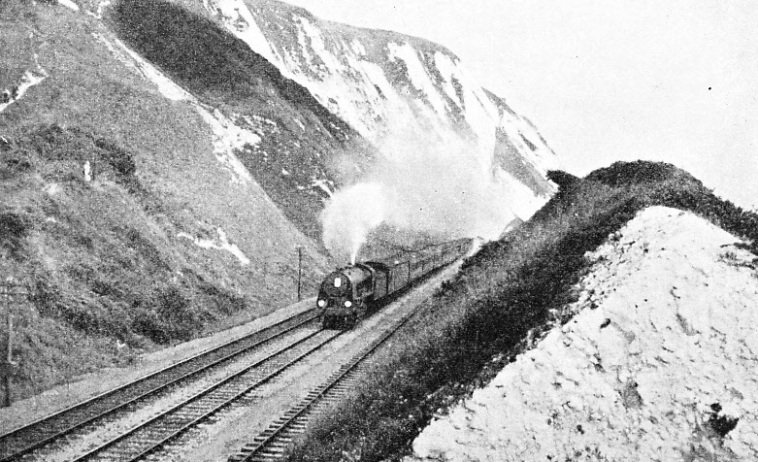


© Wonders of World Engineering 2014-


Between Folkestone and Dover, in Kent, there are six miles of crumbling chalk cliffs and a treacherous region, known as the Warren, liable to frequent slips and subsidences. Many times Nature has attempted to wreck the railway which engineers have laid and maintained in these difficult conditions
RAILWAY ENGINEERS AT WORK - 7
CONTINENTAL EXPRESS, bound for London, passing through the chalk masses which have proved so intractable between Folkestone and Dover. In the background is Abbot’s Cliff, through which the builders of the line had to bore for a distance of 1,933 yards.
ENGLAND’S white cliffs have baffled pirates and invaders for many centuries. Julius Caesar wrote that this part of Britain was made inaccessible by steep cliffs and sailed up to the more propitious shores of Thanet before disembarking his expedition.
Within the past ninety years or so the cliffs and the land between Dover and Folkestone have had a new invader to face -
In the eighteen-
The alternative of a sort of mountain railway over the top of the Downs from Folkestone to Dover would have proved a great stumbling block. Sooner or later another railway company was sure to take a rival line into Dover by way of Canterbury, and the South Eastern would have found itself the owner of a white elephant.
Sir William Cubitt, Engineer of the South Eastern Railway, determined to carry his line through the Warren itself, piercing the cliffs where they jutted out into the sea. The work was carried out during the early ‘forties of the last century, at a time when the newly proved railway was beginning to spread all over England under the powerful influence of George Hudson and others.
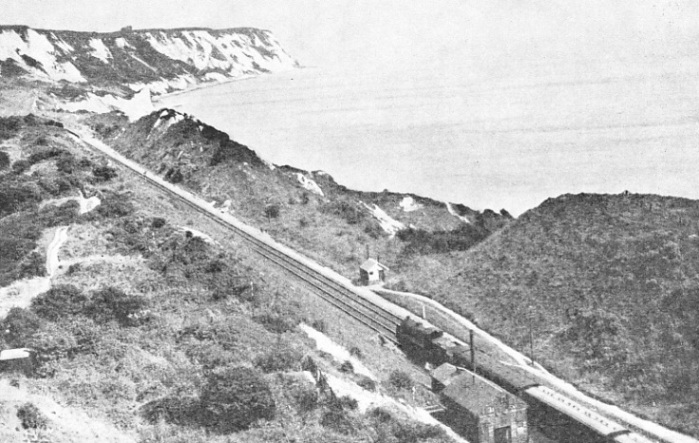
THE WARREN is an undulating area of chalk detritus caused by thousands of years of erosion and subsidence. The Warren Cutting, some two miles long, was excavated by Sir William Cubitt, the Engineer of the South Eastern Railway (now Southern Railway) in the eighteen-
Cubitt had experienced little difficulty in carrying his railway across Kent from Redhill, in Surrey, through which the original Dover main line passed. To this day the line through Tonbridge to Ashford is one of the straightest and flattest outside the Fen District. But from Folkestone to Dover Cubitt had a heavy task before him. He had first to throw a viaduct across a valley lying a little to the north of Folkestone. This viaduct is now virtually within the town itself. It contains twenty arches and is more than 100 feet high in the middle. After that came the first boring through the chalk; this bore is known as the Martello Tunnel. The distance from portal to portal is 530 yards, less than a third of a mile. Beyond the Martello Tunnel, Cubitt had to make the passage of the treacherous and hummocky length of the Warren.
The grading of the Warren section entailed heavy work. The country is rather similar to the waste land adjoining a big chalk pit, only on a much larger scale. None of it is level, all being an undulating mass caused by thousands of years of erosion and slipping. Through this Cubitt excavated the famous Warren Cutting, some two miles in length. Above it rose the dazzling white cliffs to a height of many hundreds of feet, peopled only by rabbits, jackdaws and other lovers of places inaccessible to man. On either side, between cutting and cliff and between cutting and sea, rose the whitish-
Beyond the Warren rose the high white mass of Abbot’s Cliff, through which the builders of the line had to bore for a distance of 1,933 yards. The tunnel did not present any great difficulty. The chalk within the cliff was in good condition, unlike the rotten detritus which was encountered during the passage of the Warren.
First Electric Blasting on Record
Beyond Abbot’s Cliff, and between it and Shakespeare Cliff, near Dover, came another open stretch. Here Cubitt laid his track at the foot of the cliffs with a huge sea wall on its coastwise side to protect it from the lashing of the waves. In one place, however, the way was blocked by a great projection jutting out from Round Down Cliff towards the sea.
Instead of piercing the cliff with a minor tunnel, Cubitt thought it would be better to remove that part of it which interfered with the course of his road. To do this he had to get rid of the huge intermediate mass of chalk by blasting. This blasting work is of special interest, for in it for the first time in history use was made of electricity for detonating the charges. Cubitt bored three galleries through the interior of the projecting cliff, with three distinct shafts and three charge chambers at the bottom. Into these chambers the sappers placed 18,000 lb of gunpowder. It was before the days of dynamite and of the various high explosives which are so familiar to-
The fact that an unparalleled attack was to be made on part of England’s white walls had been made widely known beforehand, and considerable crowds assembled, at a safe distance, to watch proceedings. To this day, there can be no better description of what happened than that contained in the report sent in by the special correspondent of a London newspaper. This account gives, in addition to a perfectly accurate description, some idea of the impression made by large-
Taking up his tale from the sounding of the final warning signal, the newspaperman wrote: “The next minute was one of silent and breathless and impatient expectation. Exactly at twenty-
So the line was carried past the shattered base of Round Down Cliff and into the face of Shakespeare Cliff, which it penetrated by a tunnel nearly a mile in length. Beyond Shakespeare Cliff the line ran to Dover along the base of the cliffs. This stretch, until recently, was supported on a timber trestle bridge, but a massive masonry causeway has since taken the place of the old trestle. Cubitt completed the South Eastern Railway to Dover in the following year, 1844.
But Sir William Cubitt had not conquered the cliffs and the Warren for all time. One day in 1877, 100 acres of land slipped away seawards at the eastern end of the Martello Tunnel, carrying part of the tunnel with it. Fortunately, no train was passing through at the time. Two days later, an alarming fall of chalk occurred near Abbot’s Cliff. The loosened rock crashed down from the cliffs into railway cutting below, filling it to a depth in places of 60 feet. In September 1885 the cutting was again blocked by a fall of chalk, though this time no preliminary warning slip took place in the Warren. November 1892 saw a slip which caused the main road above the Warren to sink by about 40 feet in places, and a little over four years later there was another bad slip at the western end of the Warren.
Worst Subsidence of All
The greatest slip in recorded history, which destroyed much of Sir William Cubitt’s work, apart from the tunnels themselves, took place in 1915, while the war of 1914-
It was war time and, for various reasons, extreme reticence was deemed absolutely necessary. Those in power considered that it would be most dangerous to let possible enemies know that Dover and Folkestone were cut off from each other, and that the only direct route from Dover to London that remained was that of the old London Chatham and Dover Railway, through Charlton Tunnel at the back of the town. A full technical account of the accident to the railway through the Warren was not published in the engineering Press until nearly three and a half years had elapsed. Civilian labour was scarce during the War, and immediate reconstruction of the badly damaged line was found to be impossible.
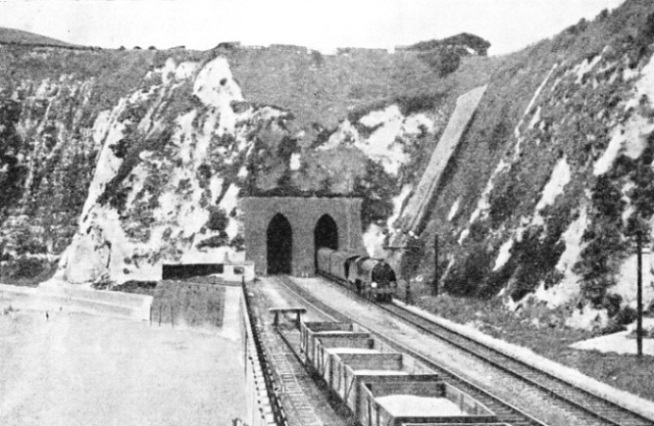
THE DISTINCTIVE DOUBLE PORTAL of the tunnel beneath Shakespeare Cliff, near Dover. The tunnel is nearly a mile long. The stretch of line in front of the portal is supported on a massive masonry causeway, built to replace a former timber trestle bridge.
Some account of the geological formation of the Warren, is necessary. In recent years engineers have built stout defences against the invading sea, which from 1851 to 1915 had encroached in places as much as 270 feet. The broken, hillocky mass of the Warren, as well as the heavy weight of the cliffs above, rests on a stratum of gault, a treacherous mass of slippery, clayey marl. The top of this stratum is not level. It varies from 140 feet below sea level at Shakespeare Cliff to 60 feet above sea level at the Dover end of the Martello Tunnel, where it is about 110 feet thick. At its seaward edge, this great clayey layer was being constantly if slowly washed away, and something was bound to collapse sooner or later.
Borings showed that at one point the thickness of the gault stratum had worn down from 150 feet to a mere 80 feet. Above the gault at that point, on the northern side, the white chalk cliffs rose to a height of 420 feet, their colossal weight being carried by that soft, slippery mass beneath. Below the cliffs lay the tumbled country of the Warren and right through this area ran the railway line.
Chalk being a porous type of rock, the weight of the superimposed mass of cliff increased greatly after heavy rain. Its slowness in drying out, causing the continued suspension of a great mass of water in the chalk, involved a heavy strain on the underlying gault, which was already partly at the mercy of the sea. The normal annual rainfall at Folkestone was about 28-
Stationary Train Derailed
Beneath the chalk, the top surface of the gault layer presented a wet, slippery surface. In turn, the greensand below the gault was highly charged with water, so much so that borings taken down some 90 feet into the greensand, in the summer of 1915, produced what amounted virtually to gusher wells, the water coming right up to the tops of the boreholes and running off into the sea.
What happened in the Warren on the fateful December 19 was this. Two hours after low tide, an enormous mass of material extending from the tops of the cliffs to the shore broke off and began to slide seawards. It did not move rapidly, and the extent of the movement was at first not unduly great. Because of the heavy rainfall, however, the line through the Warren was being closely watched. A watchman at the Folkestone end of the Warren, on the Dover side of the Martello Tunnel, heard the noise of chalk falling just after a train had left Folkestone for Dover. He knew what to expect. He and his fellows had been watching the chalk for weeks. He knew that the noise he had heard meant a rock fall somewhere down the line towards Dover. He stopped the train, therefore, as it left the Martello Tunnel, so that it came to a stand with its last coach some yards clear of the tunnel mouth.
Now that train, consisting of a locomotive and four bogie coaches, had stopped right across the western line of cleavage. The rails, by then, with the entire mass of the surrounding Warren, were beginning to move slowly seawards.
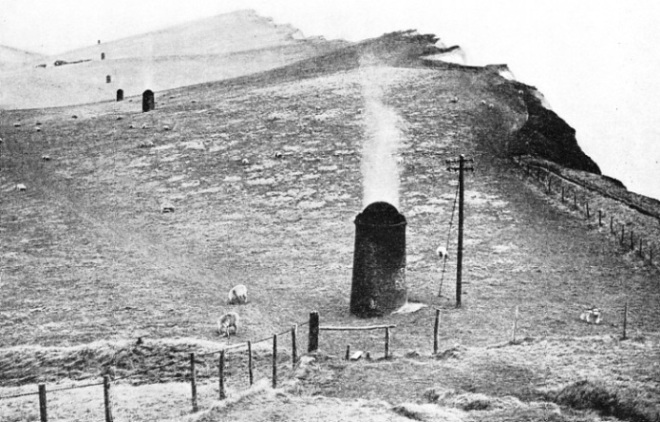
THE LONG LINE OF SMOKE VENTS protruding from the top of Shakespeare Cliff marks the line of the tunnel through the chalk mass. Shakespeare Cliff, 350 feet high, is subject to landslides through chalk weathering.
They continued, steadily, to move, becoming distorted in the process, so that first one, then another of the coaches belonging to the standing train became derailed. The train was evacuated and the passengers, having abandoned the coaches, walked back through the tunnel to Folkestone. By the time the movement of the subsidence had ceased, the train was lying in the huge hollow formed at this point, with its head and tail both pointing sharply uphill. The last coach of the four, being right on the line of cleavage, was most badly derailed. This train had a miraculous escape. Unwarned, it would have run at full speed into the slipping section, and a violent derailment would have occurred, with a heavy death-
Along the Warren, however, far worse things had happened than the accident to the train. The train had merely encroached on the western edge of the enormous slip. No less than two miles of the Warren, with its flanking cliffs and the railway line traversing it, had slid solidly seawards. The slip extended from a point 180 yards in from the Dover end of the Martello Tunnel to a natural set in the cliffs 287 yards from the Folkestone end of the Abbot’s Cliff Tunnel.
Of the railway line itself, 1 mile 715 yards had been seriously distorted. The roadbed had been ejected from beneath the sleepers in places, and the rails bent and twisted into fantastic zigzags by the movement of the underlying ground. Alinement, grading, all had vanished. The railway, as such, had been destroyed as if by a tremendous earthquake.
The little wayside platforms and sheds of Warren Halt had been carried bodily, with the railway passing between them, a distance of 159 feet towards the sea, 155 acres of the surrounding land being thus seriously disturbed. Towards the Dover end of the Warren, an enormous mass of solid chalk rock had fallen down from the summit of the cliff, burying the railway section below it completely, and extending far out from the seashore, to form a new headland of tumbled masses of broken chalk.
The movement of the land, meanwhile, had caused an upheaval of the gault lying in the sea floor, and this formed a series of offshore islands, with a ridge running parallel to the shore and reaching in places a height of 30 feet above low-
Clever Reconstruction
For several years this important section of railway, so close to France and all that France implied during the most critical period of the war, remained completely unworkable. When P. C. Tempest, the Chief Engineer of the South Eastern and Chatham Railway, was at last able to tackle the job, he realized from the beginning that it was impossible to try to restore the railway to its old position. Track and cuttings having moved bodily seawards, it was best to use them again, as much as possible, in their new position, after having levelled the sadly undulating roadbed and after having reshaped the distorted sides of the cuttings.
To obtain a new formation level for the railway, the workmen had to excavate 82,000 cubic yards of chalk and other spoil. Where the great chalk fall from the cliffs covered the old line, a new cutting had to be made through it, and this, over a stretch of only 15 chains, accounted for 64,000 yards out of the total of 82,000 cubic yards. It was possible to apply 17,000 cubic yards of this chalk usefully in embankment work, in places where the original roadbed had subsided or been shot from beneath the sleepers, as at the Warren Halt and elsewhere. The remainder of the spoil from the cutting through the big fall was useless and had to be tipped over the low cliff edge on the seaward side of the line.
In view of the treatment which the original line had received from the forces of Nature, it is remarkable to what, extent the much-
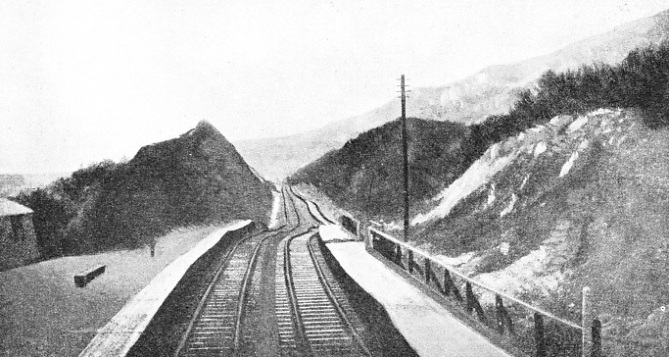
AFTER THE GREAT LANDSLIP OF 1915. On December 19 of that year occurred one of the greatest landslides known in the Warren district. Warren Halt, shown above, and the neighbouring section of line were carried bodily a distance of 159 feet towards the sea.
